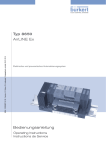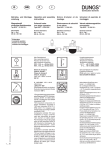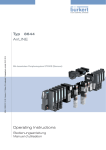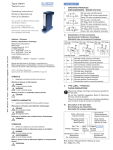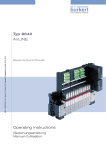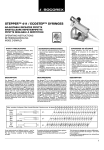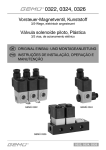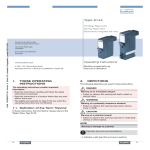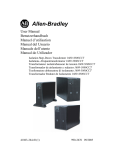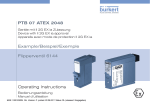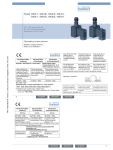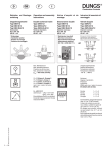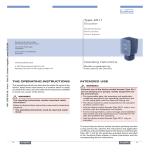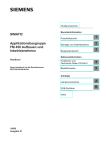Download Type 6650 - Bürkert Fluid Control Systems
Transcript
Type 6650 2/2 and 3/2-way flipper solenoid valve 2/2- und 3/2-Wege Flipper-Magnetventil Electrovanne Flipper 2/2 ou 3/2 Operating Instructions Bedienungsanleitung Manuel d‘utilisation 1 Contents OPERATING INSTRUCTIONS The operating instructions contain important information. ▶▶ Read the instructions carefully and follow the safety instructions in particular, and also observe the operating conditions. ▶▶ Instructions must be available to each user. ▶▶ The liability and warranty for Type 6650 are void if the operating instructions are not followed. 1 Operating Instructions.............................................................................................................2 2 Intended use....................................................................................................................................3 3 Basic safety instructions.......................................................................................................4 4 Technical Data...............................................................................................................................5 5 Installation......................................................................................................................................11 6 Maintenance, Troubleshooting.......................................................................................13 1.1 Definition of term 7 Transport, Storage, Disposal............................................................................................14 The term “device” used in these instructions always stands for the flipper solenoid valve type 6650. english 2 1.2 Symbols →→designates a procedure which you must carry out. ▶▶ Designates an instruction to prevent risks. Warning of injuries: DANGER! Imminent danger. Serious or fatal injuries. WARNING! Potential danger. Serious or fatal injuries. CAUTION! Danger. Minor or moderately severe injuries. Warns of damage to property: NOTE! Important tips and recommendations for safe and problem-free operation of the device. 2 INTENDED USE Incorrect use of the flipper solenoid valves type 6650 can be dangerous to people, nearby equipment and the environment. ▶▶ The device is a media-separated solenoid valve and has been designed for use in conjunction with gases and fluids (see Bürkert Chemical Resistance Chart: www.burkert.com Typ 6650). ▶▶ Do not use the device outdoors without appropriate protective measures. ▶▶ Use according to the permitted data, operating conditions and conditions of use specified in the contract documents and operating instructions. ▶▶ The device is not intended for operation without suitable power reduction electronics and must be operated only within the framework of the intended duty cycle. ▶▶ Only operate the device with suitable power reduction. ▶▶ Do not exceed the duty cycle (see Technical data). ▶▶ Only use in combination with external devices or components which have been recommended or approved by Bürkert. ▶▶ Transport, store, install, operate and maintain the device correctly as described in the operating instructions. ▶▶ Use the device only as intended. english 3 2.1 Restrictions If exporting the system/device, observe any existing restrictions. 3 BASIC SAFETY INSTRUCTIONS These safety instructions do not make allowance for any contingencies and events which may arise during installation, operation and maintenance. Danger – high pressure. ▶▶ Before loosening the lines and valves, turn off the pressure and vent the lines. Risk of burns/risk of fire if used continuously through hot device surface! ▶▶ Keep the device away from highly flammable substances and media and do not touch with bare hands. ▶▶ Do not exceed the max. permitted duty cycle (see chapter “4.1 Operating Conditions”) ▶▶ Do not obstruct the heat dissipation that is required for the operation. General hazardous situations. ▶▶ The flipper solenoid valve type 6650 is not to be used in areas where there is a risk of explosion. ▶▶ The connection clamps between coil and fluid housing must not be removed under any circumstances. ▶▶ Do not make any internal or external changes to the device. ▶▶ Do not put any loads on the housing (e.g. by placing objects on it or standing on it). ▶▶ Installation and repair work may be carried out by authorised technicians only. ▶▶ Ensure that the system cannot be activated unintentionally. ▶▶ After an interruption in the power supply or pneumatic supply, ensure that the process is restarted in a defined or controlled manner. ▶▶ The device may be operated only when in perfect condition and in consideration of the operating instructions. ▶▶ The general rules of technology apply to application planning and operation of the device. english 4 4 NOTE! Electrostatic sensitive components / modules. The power reduction electronics, which is available as an accessory, contains electronic components which react sensitively to electrostatic discharge (ESD). Contact with electrostatically charged persons or objects is hazardous to these components. In the worst case scenario, they will be destroyed immediately or will fail after start-up. • Observe the requirements in accordance with EN 61340-5-1 and 5-2 to minimize or avoid the possibility of damage caused by a sudden electrostatic discharge. • Do not touch live electronic components. TECHNICAL DATA 4.1 Operating Conditions WARNING! Risk of injury Malfunction if used outside! ▶▶ The valve must not be used outside without appropriate protective measures. ▶▶ Avoid heat sources which may cause the permitted temperature range to be exceeded. Permitted temperatures Ambient temperature: Medium temperature: +10...+50 °C +15...+50 °C Media: aggressive and neutral gaseous and liquid media according to resistance (see Bürkert Chemical Resistance Chart) english Max. duty cycle:50 s for block structure 60 s for single mounting Longer duty cycle permitted with power reduction electronics only (see chapter “4.5 Electrical data”) 4.2 Mechanical data (without electrical connector plug) Add-on dimension 4.5 mm Weight: 12.5 g Degree of protection:IP65 to EN 60529 Dimensions: 4.5 x 38.5 x 41.2 mm Protection class: Housing material: PEEK Sealing material: FFKM 3 acc. to VDE 0580 WARNUNG! Risk of injury due to leaking medium. Connecting clamps might become loose when applying lateral, compressive or tensile force. ▶▶ Do not stress the device mechanically. ▶▶ Do not apply lateral, compressive or tensile force to Force F Force F the device. Connecting clamps 6 english 5 4.3 Fluidic data NC IN 3/2-way universal Circuit function T *) DN = Orifice Example: Orifice [DN] Circuit function Sealing material (CC=FFKM FF = FKM) Housing material (PK=PEEK) Made in Germany Type ΔP max. *** IN ) 0,4 vak -7 bar 0,8 - **) DN NC COM NO 0,8 vak -1 bar vak 1 bar vak -1 bar 1 bar DN NC COM NO ΔP max. ***) 0,8 - **) vak 3 bar - **) 3 bar NC NO NC NO COM 6650 T 0,8 CC PK 24V-PWM vac-1bar 00189292 Voltage Pressure range Identification number vak -7 bar 7 bar vak -3 bar 3 bar COM 3/2-way distributor Circuit function F 4.4 Label / Identification of connections Made in Germany **)Observe direction of flow. Output pressure must not be higher than input pressure. ***)In vacuum mode observe permitted differential pressure. DN*) NC 2/2-way NC Circuit function A Identification of the fluid connections ΔP max. ***) 4.5 Electrical data Connections:Type-specific plug-in connector, see data sheet Electrical power supply:12 V, 24 V Voltage tolerance: ± 10 % Power input: Start/activation impulse: 5.7 W Holding power: 0.7 W english For the continuous operation of valve type 6650, a power reduction electronics is required. It is recommended to use the electronics, which is available as an accessory (see data sheet). NOTE! Malfunction due to overheating! ▶▶ The coil temperature must not exceed 110 ° C. ▶▶ If required, use suitable power reduction electronics. ▶▶ For a switch-on time > 50 s (for single mounting > 60 s) always use a power reduction electronics! ▶▶ The electronics 670178, available as an accessory, are suitable for a nominal voltage of 24 V only. The following graphs provide a guideline for estimating whether a power reduction electronics is required. If the gap between the individual units is < 10 mm, use the graph for the block structure. A power reduction electronics is not required if the intersection point of switchon and switch-off time is in the upper area of the corresponding graph. 7 6 5 4 3 2 1 0 10 20 30 40 50 60 switch-on time [s] 0 0,5 1 1,5 2 2,5 3 switch-on time [s] 3,5 4 4,5 5 If the intersection point is on or below the plotted line or if the duty cycle is longer than 60 seconds, power reduction electronics are essential. In case the Bürkert electronics is not used, but another power reduction electronics is implemented, the following parameters should be applied: in case of a PWM voltage drop: Duty cycle 33 %, f=20kHz Block structure (Pulse / interval ratio at ambient temperature of 22 °C) switch-off time [s] 400 350 300 250 200 150 100 50 0 0 Example: 40 s on - 100 s off → power reduction electronics required english 8 switch-off time [s] switch-off time [s] 4.5.1Continuos operation with power reduction electronics Single device (Pulse / interval ratio at ambient temperature of 22 °C) switch-off time [s] The indicated values (power consumption) describe the heat output. When designing the power supply, pay attention to appropriate reserves. 7 1200 1000 800 600 400 200 0 U PWM-signal 20 kHz switch-off point 100 % 0 60 5 10 15 20 25 30 35 40 switch-on time [s] Example: 6 s on - 40 s off → power reduction electronics not required 45 50 50 0 5 ms switch-on pulse 40 30 t 20 10 0 0 1 2 3 4 5 6 switch-on time [s] 7 8 9 10 If the intersection point is on or below the plotted line or if the duty cycle is longer than 50 seconds, power reduction electronics are essential. english 9 For OEM electronics (PWM) recommended circuit diagram: for resistance reduction: Switch-on pulse 100 % nominal voltage for 5 ms, then holding voltage 35 % nominal voltage Circuit diagram for 24 V design U 100 % GND GND VDD D5 1N4148 C3 100nF GND holding voltage R2 41k 7 6 5 2 C2 470pF GND switch-off point 35 % 0 t 5 ms Switch-on pulse VDD D3 1N4148 D4 1N4148 D2 BYM05-200 GND VDD R3 100k C1 1uF D1 ZMM5.1V R4 330R 8 4 3 1 For OEM electronics (resistance reduction) recommended circuit diagram: TR1 IRLL2705 Circuit diagram for 24 V design Connection coil R1 3k3 (24V) 1k2 (12V) valve supply voltage VDD TI1 TLC555 GND GND Caution : Drop approx. 1.6 W Alternatively series or parallel connection of several resistors english 10 5 INSTALLATION 5.2 Fluid Installation DANGER! 5.1 Safety instructions DANGER! Danger – high pressure in the equipment. ▶▶ Before loosening the lines and valves, turn off the pressure and vent the lines. Danger – high pressure in the equipment. ▶▶ Before loosening the lines and valves, turn off the pressure and vent the lines. Installation position: any, actuator preferably upwards. Procedure: WARNING! →→Before installation, clean any possible dirt off the pipelines and Risk of injury from improper installation. ▶▶ Installation may be carried out by authorised technicians only and with the appropriate tools! Risk of injury from unintentional activation of the system and an uncontrolled restart. ▶▶ Secure system from unintentional activation. ▶▶ Following installation, ensure a controlled restart. flange connections. →→Install a dirt trap to prevent malfunctions (Mesh size: 5 µm). WARNING! Danger through spillage of medium. Leaking connections if seal seated incorrectly. ▶▶ Ensure that the supplied sealing gasket is seated correctly. english 2-way normally closed: max. ∅ 1.4 4.8 33 3-way universal function: max. ∅ 1.4 4.8 33 M2 min. 6 deep Flange screws Recommended torque: 0.35 Nm ± 0.1 Nm Dimensional drawing for manifold: M2 min. 6 deep The add-on dimension must not fall short of 4.5 mm! 11 →→Check valve for leakage. 4.5 mm Sealing gasket Manifold →→Insert the sealing gasket into the valve. →→Correctly allocate the fluid connection configuration 1, 2 and 3 to the valve and the manifold. →→Screw valve onto the manifold. 12 english 5.3 Electrical Installation NOTE! Without proper power reduction electronics, the valve type 6650 is not suitable for continuous operation! Please refer to the chapter titled “4.5 Electrical data”. In the block structure all valves must be poled identically. The mark (+) on the valve and the numerals 1 and 2 on the plug-in connector are used as orientation. Example: On all units the plug-in connector with numeral 2 points to the mark (+). 6 MAINTENANCE, TROUBLESHOOTING 6.1 Safety instructions plug-in connector 1 = brown 2 = white If the power reduction electronics are used, observe the following polarity: brown + / white -. A type-specific plug-in connector with or without integrated power reduction electronics is available as an accessory (see data sheet). DANGER! Danger – high pressure in the equipment. ▶▶ Before loosening the lines and valves, turn off the pressure and vent the lines. WARNING! Risk of injury from improper maintenance. ▶▶ Maintenance may be carried out by authorised technicians only and with the appropriate tools. Risk of injury from unintentional activation of the system and an uncontrolled restart. ▶▶ Secure system from unintentional activation. ▶▶ Following maintenance, ensure a controlled restart. english 6.2 Maintenance Work 7 The valve is maintenance-free under normal operating conditions. NOTE! If the exterior is very dirty, it is recommended to clean it with suitable cleaning agents. If required, determine the suitability of the cleaning agent by conducting a test. WARNING! Discharge of medium and malfunction if the connection clamps are removed. ▶▶ The connection clamps between coil and fluid housing must not be removed. 6.3 Malfunctions If operating with power reduction electronics, ensure that the power supply flank is quick enough. If malfunctions occur, check →→the line connections →→the operating pressure →→the power supply and valve control TRANSPORT, STORAGE, DISPOSAL Transport damages. Inadequately protected equipment may be damaged during transport. ▶▶ During transportation protect the device against wet and dirt in shockresistant packaging. ▶▶ Avoid exceeding or dropping below the permitted storage temperature. Incorrect storage may damage the device. ▶▶ Store the device in a dry and dust-free location. ▶▶ Storage temperature: -10...65 °C. Damage to the environment caused by device components contaminated with media. ▶▶ Observe applicable regulations on disposal and the environment. ▶▶ Observe national waste disposal regulations. If the valve still does not switch, please contact your Bürkert Service. 14 english Bürkert Fluid Control Systems Sales Center Christian-Bürkert-Str. 13-17 D-74653 Ingelfingen Tel. + 49 (0) 7940 - 10 91 111 Fax + 49 (0) 7940 - 10 91 448 E-mail: [email protected] International address www.burkert.com Manuals and data sheets on the Internet: www.burkert.com Bedienungsanleitungen und Datenblätter im Internet: www.buerkert.de Manuels d'utilisation et fiches techniques sur Internet : www.buerkert.fr © 2015 Bürkert Werke GmbH Operating Instructions 1503/08_EU-ML_6650 / Original DE www.burkert.com 13 Type 6650 2/2 and 3/2-way flipper solenoid valve 2/2- und 3/2-Wege Flipper-Magnetventil Electrovanne Flipper 2/2 ou 3/2 Operating Instructions Bedienungsanleitung Manuel d‘utilisation 1 Inhaltsverzeichnis DIE BEDIENUNGSANLEITUNG Die Bedienungsanleitung enthält wichtige Informationen. ▶▶ Die Anleitung sorgfältig lesen und besonders die Hinweise zur Sicherheit beachten. ▶▶ Die Anleitung so aufbewahren, dass sie jedem Benutzer zur Verfügung steht. ▶▶ Die Haftung und Gewährleistung für Typ 6650 entfällt, wenn die Anweisungen der Bedienungsanleitung nicht beachtet werden. 1 Die Bedienungsanleitung..................................................................................................15 2 Bestimmungsgemäßer Gebrauch...............................................................................16 3 Grundlegende Sicherheitshinweise..........................................................................17 4 Technische Daten....................................................................................................................19 5 Installation......................................................................................................................................24 6 Wartung, Fehlerbehebung.................................................................................................27 1.1 Begriffsdefinition Gerät 7 Transport, Lagerung, Entsorgung................................................................................28 Der in dieser Anleitung verwendeten Begriff „Gerät“ steht immer für den Typ 6650. deutsch 1.2 Darstellungsmittel →→markiert einen Arbeitsschritt den Sie ausführen müssen. ▶▶ markiert eine Anweisung zur Gefahrenvermeidung. Warnung vor Verletzungen: GEFAHR! Unmittelbare Gefahr. Schwere oder tödliche Verletzungen. WARNUNG! Mögliche Gefahr. Schwere oder tödliche Verletzungen. VORSICHT! Gefahr. Mittelschwere oder leichte Verletzungen. Warnung vor Sachschäden: HINWEIS! Wichtige Tipps und Empfehlungen für die Sicherheit und einwandfreie Funktion des Geräts. 16 deutsch 2 15 BESTIMMUNGSGEMÄSSER GEBRAUCH Bei nicht bestimmungsgemäßem Einsatz der Flipper-Magnetventile Typ 6650 können Gefahren für Personen, Anlagen in der Umgebung und die Umwelt entstehen. ▶▶ Das Gerät ist ein mediengetrenntes Magnetventil und zum Einsatz bei Gasen und Flüssigkeiten konzipiert (siehe Bürkert Beständigkeitstabelle: www.buerkert.de → Typ 6650). ▶▶ Für den Einsatz die in den Vertragsdokumenten und der Bedienungsanleitung spezifizierten zulässigen Daten, Betriebs- und Einsatzbedingungen beachten. Das Gerät ▶▶ Das Gerät nicht ohne passende Schutzvorkehrungen im Außenbereich einsetzen. ▶▶ Das Gerät nur mit geeigneter Leistungsabsenkung betreiben. ▶▶ Die Einschaltdauer nicht überschreiten (siehe Technische Daten). ▶▶ Nur in Verbindung mit von Bürkert empfohlenen bzw. zugelassenen Fremdgeräten und -komponenten einsetzen. ▶▶ Nur in einwandfreiem Zustand betreiben und auf sachgerechte Lagerung, Transport, Installation und Bedienung achten. ▶▶ Nur bestimmungsgemäß einsetzen. 3 2.1 Beschränkungen Beachten Sie bei der Ausfuhr des Systems oder Geräts gegebenenfalls bestehende Beschränkungen. GRUNDLEGENDE SICHERHEITSHINWEISE Diese Sicherheitshinweise berücksichtigen keine Zufälligkeiten und Ereignisse, die bei Montage, Betrieb und Wartung auftreten können. Gefahr durch hohen Druck. ▶▶ Vor dem Lösen von Leitungen und Ventilen den Druck abschalten und Leitungen entlüften. Verbrennungsgefahr/Brandgefahr bei Dauerbetrieb durch heiße Geräteoberfläche. ▶▶ Das Gerät von leicht brennbaren Stoffen und Medien fernhalten und nicht mit bloßen Händen berühren. ▶▶ Die max. zulässige Einschaltdauer nicht überschreiten (siehe Kapitel „4.1 Betriebsbedingungen“). •Die für den Betrieb notwendige Wärmeabfuhr nicht behindern. Allgemeine Gefahrensituationen ▶▶ Den Typ 6650 nicht in explosionsgefährdeten Bereichen einsetzen. deutsch ▶▶ Die Verbindungsklammern zwischen Spule und Fluidgehäuse dürfen unter keinen Umständen entfernt werden. ▶▶ Am Gerät keine inneren oder äußeren Veränderungen vornehmen. ▶▶ Das Gehäuse und die Spule nicht mechanisch belasten. ▶▶ Nur geschultes Fachpersonal darf Installations- und Instandhaltungsarbeiten ausführen. ▶▶ Darauf achten, dass die Anlage nicht unbeabsichtigt betätigt werden kann. ▶▶ Nach einer Unterbrechung der elektrischen oder pneumatischen Versorgung für einen definierten oder kontrollierten Wiederanlauf des Prozesses sorgen. ▶▶ Das Gerät nur in einwandfreiem Zustand und unter Beachtung der Bedienungsanleitung betreiben. ▶▶ Für die Einsatzplanung und den Betrieb des Geräts die allgemeinen Regeln der Technik einhalten. HINWEIS! Elektrostatisch gefährdete Bauelemente / Baugruppen. Das Gerät enthält elektronische Bauelemente, die gegen elektrostatische Entladung (ESD) empfindlich reagieren. Berührung mit elektrostatisch aufgeladenen Personen oder Gegenständen gefährdet diese Bauelemente. Im schlimmsten Fall werden sie sofort zerstört oder fallen nach der Inbetriebnahme aus. •Die Anforderungen nach EN 61340-5-1 beachten, um die Möglichkeit eines Schadens durch schlagartige elektrostatische Entladung zu minimieren bzw. zu vermeiden! • Elektronische Bauelemente nicht bei anliegender Versorgungsspannung berühren! deutsch 18 4 17 TECHNISCHE DATEN 4.1 Betriebsbedingungen WARNUNG! Verletzungsgefahr Funktionsausfall bei Einsatz im Außenbereich! ▶▶ Das Ventil darf nicht ohne passende Schutzvorkehrungen im Außenbereich eingesetzt werden. ▶▶ Wärmequellen vermeiden, die zur Überschreitung des zulässigen Temperaturbereichs führen können. Zulässige Temperaturen Umgebungstemperatur: +10...+50 °C Mediumstemperatur: +15...+50 °C Medien: aggressive, neutrale gasförmige und flüssige Medien entsprechend Beständigkeit (siehe Bürkert Beständigkeitstabelle) Längere Einschaltdauer nur mit Leistungsabsenkung zulässig (siehe Kapitel „4.5 Elektrische Daten“) Schutzart: IP65 nach EN 60529 Schutzklasse:3 nach VDE 0580 WARNUNG! Verletzungsgefahr durch Mediumsaustritt. Seitliche Krafteinwirkung, Druck- oder Zugkraft, kann zum Lösen der Verbindungsklammern führen. ▶▶ Gerät darf nicht mechanisch belastet werden. ▶▶ Keine seitliche Krafteinwirkung, Druck- oder Zugkraft, Kraft F Kraft F auf das Gerät ausüben. Verbindungsklammern Max. Einschaltdauer: 5 0 s bei Blockaufbau 60 s bei Einzelmontage deutsch 19 4.2 Mechanische Daten 4.3 Fluidische Daten (ohne elektrischen Stecker) **)Durchflussrichtung beachten. Ausgangsdruck darf nicht höher sein als Eingangsdruck. ***)Bei Vakuumbetrieb zulässigen Differenzdruck beachten. Anreihmaß: 4,5 mm Gewicht: 12,5 g Maße: 4,5 x 38,5 x 41,2 mm Gehäusematerial: PEEK *) DN = Nennweite DN*) NC IN ΔP max. ***) NC 0,4 vak -7 bar vak -7 bar 7 bar IN 0,8 - **) DN NC 0,8 vak -1 bar DN NC COM NO ΔP max. ***) 0,8 - **) vak 3 bar - **) 3 bar 2/2-Wege NC Wirkungsweise A Dichtungsmaterial:FFKM Made in Germany 3/2-Wege Universal Wirkungsweise T COM NC NO 3/2-Wege Verteiler Wirkungsweise F NC NO COM vak -3 bar 3 bar NO ΔP max. ***) COM vak vak -1 bar 1 bar 1 bar deutsch 20 4.4 Typschild / Anschlusskennzeichung Beispiel: Nennweite [DN] Made in Germany Typ, Wirkungsweise 6650 T 0,8 CC PK 24V-PWM vac-1bar 00189292 Dichtungsmaterial (CC=FFKM FF = FKM) Gehäusematerial (PK=PEEK) Kennzeichnung der fluidischen Anschlüsse Identnummer 4.5 Elektrische Daten Anschlüsse:typspezifischer Steckverbinder, siehe Datenblatt Spannungsversorgung:12 V, 24 V Spannungstoleranz: Für den kontinuierlichen Betrieb des Ventils Typ 6650 ist eine Leistungsabsenkung erforderlich. Es wird empfohlen, die als Zubehör erhältliche Elektronik zu verwenden (siehe Datenblatt). HINWEIS! Druckbereich Spannung 4.5.1Kontinuierlicher Betrieb mit Leistungsabsenkung ± 10 % Leistungsaufnahme: Anzugs-/Einschaltimpuls: 5,7 W Halteleistung: 0,7 W Die angegebenen Werte (Leistungsaufnahme) beschreiben die Warmleistung. Bei der Auslegung der Stromversorgung auf entsprechende Reserven achten. Funktionsausfall durch Überhitzung. ▶▶ Die Spulentemperatur darf 110 °C nicht überschreiten. ▶▶ Wenn erforderlich, geeignete Leistungsabsenkung verwenden. ▶▶ Für eine Einschaltzeit > 50 s (bei Einzelmontage > 60 s) ist immer eine Leistungsabsenkung zu verwenden! ▶▶ Die als Zubehör lieferbare Elektronik 670178 ist nur für Nennspannung 24 V geeignet. Nachfolgende Diagramme bieten eine Richtlinie, um die Notwendigkeit einer Leistungsabsenkung abschätzen zu können. Bei einem Abstand der Einzelgeräte < 10 mm ist das Diagramm für den Blockaufbau zugrunde zu legen. Keine Leistungsabsenkung ist notwendig, wenn der Schnittpunkt von Ein- und Ausschaltzeit im oberen Bereich des entsprechenden Diagramms liegt. deutsch 7 6 5 4 3 2 1 0 Beispiel: 40 s ein - 100 s aus → Leistungsabsenkungselektronik erforderlich 10 20 30 Einschaltzeit [s] Ausschaltzeit [s] 400 350 300 250 200 150 100 50 0 0 Blockaufbau (Impuls-/Pausenverhältnis bei 22 °C Umgebungstemperatur) 40 50 0 5 10 15 20 25 30 35 40 45 Einschaltzeit [s] Beispiel: 6 s ein - 40 s aus → k eine Leistungsabsenkungselektronik erforderlich 50 0 1 2 3 10 60 0 0,5 1 1,5 2 2,5 3 Einschaltzeit [s] 3,5 4 4,5 5 Liegt der Schnittpunkt auf oder unterhalb der eingezeichneten Linie oder ist die Einschaltzeit länger als 60 Sekunden ist eine Leistungsabsenkung zwingend erforderlich. 22 1200 1000 800 600 400 200 0 60 Ausschaltzeit [s] Ausschaltzeit [s] Ausschaltzeit [s] Einzelgerät (Impuls-/Pausenverhältnis bei 22 °C Umgebungstemperatur) 21 deutsch 50 40 30 20 10 0 4 5 6 Einschaltzeit [s] 7 8 9 Liegt der Schnittpunkt auf oder unterhalb der eingezeichneten Linie oder ist die Einschaltzeit länger als 50 Sekunden ist eine Leistungsabsenkung zwingend erforderlich. PWM-Signal 20 kHz Abschaltpunkt 100 % VDD R1 3k3 (24V) 1k2 (12V) GND GND VDD 0 5 ms Einschaltimpuls D5 1N4148 t C3 100nF VDD R2 41k D3 1N4148 D4 1N4148 GND D2 BYM05-200 GND VDD R3 100k C1 1uF D1 ZMM5.1V C2 470pF 7 6 5 2 GND R4 330R 8 4 3 1 TR1 IRLL2705 TI1 TLC555 GND GND deutsch 5 •bei Widerstandsabsenkung, Einschaltimpuls 100 % Nennspannung für 5 ms, danach Haltespannung 35 % Nennspannung. Ventil U Für OEM-Elektroniken (PWM) empfohlener Schaltplan: Schaltplan für 24 V Auslegung Versorgungsspannung Wird die Bürkert Elektronik nicht verwendet, aber dennoch eine Leistungsabsenkung eingesetzt, sind folgende Parameter zu verwenden: •bei PWM Spannungsabsenkung, Tastgrad 33 %, f = 20 kHz. 23 INSTALLATION 5.1 Sicherheitshinweise U 100 % GEFAHR! Haltespannung 35 % Verletzungsgefahr durch hohen Druck in der Anlage. ▶▶ Vor dem Lösen von Leitungen und Ventilen den Druck abschalten und Leitungen entlüften. Abschaltpunkt 0 t 5 ms Einschaltimpuls Für OEM-Elektroniken (Widerstandsabsenkung) empfohlener Schaltplan: Anschluss Spule Schaltplan für 24 V Auslegung WARNUNG! Verletzungsgefahr bei unsachgemäßer Installation. ▶▶ Die Installation darf nur autorisiertes Fachpersonal mit geeignetem Werkzeug durchführen. Verletzungsgefahr durch ungewolltes Einschalten der Anlage und unkontrollierten Wiederanlauf. ▶▶ Anlage vor unbeabsichtigtem Betätigen sichern. ▶▶ Nach der Installation einen kontrollierten Wiederanlauf gewährleisten. Achtung: Leistungsaufnahme ca. 1,6 W Alternativ Reihen- oder Parallelschaltung mehrerer Widerstände deutsch 24 5.2 Fluidische Installation GEFAHR! Das Anreihmaß von 4,5 mm darf nicht unterschritten werden. Verletzungsgefahr durch hohen Druck in der Anlage. ▶▶ Vor dem Lösen von Leitungen und Ventilen den Druck abschalten und Leitungen entlüften. Flanschschrauben Empfohlenes Anziehdrehmoment: 0,35 Nm ± 0,1 Nm Einbaulage: beliebig, vorzugsweise Antrieb nach oben. Vorgehensweise: →→Vor der Montage Rohrleitungen und Flanschanschlüsse von eventuellen Verschmutzungen säubern. →→Zum Schutz vor Störungen einen Schmutzfänger einbauen (Maschenweite: 5 µm). 4,5 Dichtmatte Anschlussplatte WARNUNG! Gefahr durch Mediumsaustritt. Undichte Anschlüsse bei unkorrekt sitzender Dichtung. ▶▶ Achten Sie auf den richtigen Sitz der mitgelieferten Dichtmatte. mm →→Dichtmatte in das Ventil einlegen. →→Fluidische Anschlussbelegung 1, 2 und 3 an Ventil und Anschlussplatte richtig zuordnen. →→Ventil auf Anschlussplatte schrauben. deutsch 25 Maßzeichnung für Anschlussplatte: max. ∅ 1,4 max. ∅ 1,4 4,8 33 4,8 33 M2 min. 6 tief 3-Wege-Ausführung: M2 min. 6 tief 2-Wege-Ausführung: →→Ventil auf Dichtheit prüfen. Steckverbinder 1 = braun 2 = weiß Bei Verwendung der Leistungabsenkungselektronik ist folgende Polarität zu beachten: braun + / weiß –. 5.3 Elektrische Installation HINWEIS! Das Ventil Typ 6650 ist ohne eine bestimmungsgemäße Leistungsabsenkung nicht für den Dauerbetrieb geeignet. Siehe Kapitel „4.5 Elektrische Daten“. Ein typspezifischer Steckverbinder ist als Zubehör (siehe Datenblatt) sowohl mit als auch ohne integrierte Leistungsabsenkungselektronik erhältlich. Im Blockaufbau müssen alle Ventile gleich gepolt sein. Als Orientierung dient die Markierung (+) am Ventil und die Ziffern 1 und 2 auf dem Steckverbinder. Beispiel: Bei allen Geräten zeigt der Steckverbinder mit der Ziffer 2 zur Markierung (+). deutsch 26 6 WARTUNG, FEHLERBEHEBUNG 6.1 Sicherheitshinweise GEFAHR! Verletzungsgefahr durch hohen Druck in der Anlage. ▶▶ Vor dem Lösen von Leitungen und Ventilen den Druck abschalten und Leitungen entlüften. WARNUNG! Verletzungsgefahr bei unsachgemäßen Wartungsarbeiten. ▶▶ Die Wartung darf nur autorisiertes Fachpersonal mit geeignetem Werkzeug durchführen. Verletzungsgefahr durch ungewolltes Einschalten der Anlage und unkontrollierten Wiederanlauf. ▶▶ Anlage vor unbeabsichtigtem Betätigen sichern. ▶▶ Nach der Wartung einen kontrollierten Wiederanlauf gewährleisten. 6.2 Wartungsarbeiten Das Ventil arbeitet unter Normalbedingungen wartungsfrei. Bei starker äußerer Verschmutzung wird eine Reinigung mit geeigneten Reinigungsmitteln empfohlen. Die Eignung des Reinigungsmittels sollte gegebenenfalls per Test ermittelt werden. WARNUNG! Mediumsaustritt und Fehlfunktion bei Entfernen der Verbindungsklammern. ▶▶ Die Verbindungsklammern zwischen Spule und Fluidgehäuse dürfen nicht entfernt werden. 6.3 Störungen Bei Betrieb mit Leistungsabsenkungselektronik darauf achten, dass die Flanke der Versorgungsspannung genügend schnell ist. Überprüfen Sie bei Störungen →→die Leitungsanschlüsse, →→den Betriebsdruck, →→die Spannungsversorgung und Ventilansteuerung. deutsch Falls das Ventil dennoch nicht schaltet, wenden Sie sich bitte an Ihren Bürkert-Service. 7 TRANSPORT, LAGERUNG, ENTSORGUNG HINWEIS! Transportschäden. Unzureichend geschützte Geräte können durch den Transport beschädigt werden. ▶▶ Gerät vor Nässe und Schmutz geschützt in einer stoßfesten Verpackung transportieren. ▶▶ Eine Über- bzw. Unterschreitung der zulässigen Lagertemperatur vermeiden. Falsche Lagerung kann Schäden am Gerät verursachen. ▶▶ Gerät trocken und staubfrei lagern. ▶▶ Lagertemperatur –10…+65 °C. 28 deutsch Umweltschäden durch von Medien kontaminierte Teile. ▶▶ Gerät und Verpackung umweltgerecht entsorgen. ▶▶ Geltende Entsorgungsvorschriften und Umweltbestimmungen einhalten. 27 Bürkert Fluid Control Systems Sales Center Christian-Bürkert-Str. 13-17 D-74653 Ingelfingen Tel. + 49 (0) 7940 - 10 91 111 Fax + 49 (0) 7940 - 10 91 448 E-mail: [email protected] International address www.burkert.com Manuals and data sheets on the Internet: www.burkert.com Bedienungsanleitungen und Datenblätter im Internet: www.buerkert.de Manuels d'utilisation et fiches techniques sur Internet : www.buerkert.fr © 2015 Bürkert Werke GmbH Operating Instructions 1503/08_EU-ML_6650 / Original DE www.burkert.com Type 6650 2/2 and 3/2-way flipper solenoid valve 2/2- und 3/2-Wege Flipper-Magnetventil Electrovanne Flipper 2/2 ou 3/2 Operating Instructions Bedienungsanleitung Manuel d‘utilisation 1 Sommaire 1 Manuel d’utilisation..................................................................................................................29 2 Utilisation conforme...............................................................................................................30 3 Consignes de sécurité fondamentales...................................................................31 4 Caractéristiques techniques............................................................................................33 5 Installation......................................................................................................................................38 6 Maintenance, dépannage..................................................................................................41 7 Transport, Stockage, Elimination..................................................................................42 MANUEL D’UTILISATION Manuel d’utilisation contiennent des informations importantes. ▶▶ Lire attentivement ce manuel et respecter les consignes de sécurité. ▶▶ Le manuel doit être à disposition de chaque utilisateur. ▶▶ Nous déclinons toute responsabilité et n’accordons aucune garantie légale pour le type 6650 en cas de non-respect des instructions figurant dans ce manuel d’utilisation. 1.1 Définition du terme Le terme « appareil» utilisé dans ce manuel désigne toujours l’électrovanne type 6650. français 1.2 SYMBOLES →→identifie une opération que vous effectuer. ▶▶ Identifie une instruction visant à éviter un danger. Mise en garde contre les blessures : DANGER! Danger imminent. Les blessures graves ou mortelles. AVERTISSEMENT! Danger possible. Les blessures graves ou mortelles. ATTENTION! Danger. Les blessures légères ou moyennement graves. Met en garde contre des dommages matériels: REMARQUE! Conseils et recommandations importants pour la sécurité et le parfait fonctionnement de l’appareil. 30 29 2 UTILISATION CONFORME L’utilisation non conforme des vannes magnétiques Flipper de type 6650 peut présenter des dangers pour les personnes, les installations proches et l’environnement. ▶▶ L'appareil est une électrovanne avec séparation des fluides destinées aux gaz et aux liquides (voir « Résistances chimique « Bürkert: www. burkert.fr Typ 6650). ▶▶ N'utilisez pas l'appareil à l'extérieur sans mesures de protection adaptées. ▶▶ Lors de l'utilisation, il convient de respecter les données et conditions d'utilisation et d'exploitation admissibles spécifiées dans le manuel d’utilisation et dans les documents contractuels. ▶▶ L'appareil n'est pas destiné au fonctionnement sans une baisse de puissance adaptée, ou doit uniquement être exploité dans le cadre de la durée d'enclenchement conforme. ▶▶ L’appareil ne doit fonctionner qu’avec une réduction de puissance appropriée. ▶▶ Ne pas dépasser la durée de mise en marche (voir Caractéristiques techniques). français ▶▶ Utiliser uniquement en association avec des appareils et composants externes recommandés ou agréés par Bürkert. ▶▶ Transporter, stocker, installer, manœuvrer et entretenir l‘appareil de manière appropriée comme décrit dans le mode d‘emploi. ▶▶ Veillez à ce que l’utilisation de l’appareil soit toujours conforme. 2.1 Limitations Lors de l’exportation du système/de l’appareil, veuillez respecter les limitations éventuelles existantes. 3 CONSIGNES DE SÉCURITÉ FONDAMENTALES Ces consignes de sécurité ne tiennent pas compte des hasards et des événements pouvant survenir lors du montage, de l’exploitation et de l’entretien. AVERTISSEMENT! Danger dû à la haute pression. ▶▶ Avant de desserrer les conduites et les vannes, coupez la pression et purgez l’air des conduites. Risque de brûlures/d’incendie en fonctionnement continu dû à des surfaces d’appareils brûlantes. ▶▶ Tenez les substances et les fluides facilement inflammables à l’écart de l’appareil et ne touchez pas ce dernier à mains nues. ▶▶ Ne pas dépasser la durée d‘enclenchement max. admissible (voir chapitre « 4.1 Conditions d’exploitation ») ▶▶ Ne pas gêner l’évacuation de la chaleur nécessaire au fonctionnement. français Situations dangereuses d’ordre général. ▶▶ La électrovanne Flipper type 6650 ne doit pas être utilisée dans des zones présentant des risques d’explosion. ▶▶ Les brides de raccordement entre la bobine et le boîtier fluidique ne doivent en aucun cas être retirées. ▶▶ Ne pas apporter de modifications intérieures ou extérieures à l‘appareil. ▶▶ Ne pas exposer le corps et la bobine à des sollicitations mécaniques. ▶▶ Les travaux d’installation et de maintenance doivent être effectués uniquement par des techniciens qualifiés et habilités disposant de l’outillage approprié. ▶▶ Veiller à ce que l‘installation ne puisse pas être actionnée de manière intempestive. ▶▶ Après une interruption de l’alimentation électrique ou pneumatique, un redémarrage défini ou contrôlé du processus doit être garanti. ▶▶ L’appareil doit être utilisé uniquement en parfait état et en respectant le manuel d’utilisation. ▶▶ Les règles générales de la technique sont d’application pour planifier l’utilisation et utiliser l’appareil. REMARQUE ! Eléments/sous-groupes sujets aux risques électrostatiques. L'électronique de baisse de puissance disponible sous forme d'accessoire contient des éléments électroniques sensibles aux décharges électrostatiques (ESD). Ces éléments sont affectés par le contact avec des personnes ou des objets ayant une charge électrostatique. Au pire, ils sont immédiatement détruits ou tombent en panne après mise en service. • Respecter les exigences selon EN 61340-5-1 et 5-2 afin de minimiser ou éviter le risque d‘un dommage par une décharge électrostatique brusque. • Ne pas toucher les composants électroniques lorsque la tension d‘alimentation est présente. français 32 4 31 CARACTÉRISTIQUES TECHNIQUES Une durée d‘enclenchement plus longue est uniquement admissible moyennant une baisse de puissance (voir chapitre « 4.5 Caractéristiques électriques ») 4.1 Conditions d’exploitation AVERTISSEMENT ! Risque de blessures Panne lors de l'utilisation à l'extérieur. ▶▶ La vanne ne doit pas être utilisée à l'extérieur sans les mesures de protection adaptées. ▶▶ Eviter les sources de chaleur pouvant entraîner le dépassement de la plage de température admissible. Températures admissibles Température ambiante : +10...+50 °C Température du fluide : +15...+50 °C Fluides : Fluides liquides et gazeux, agressifs et neutres, conformément à la résistance (voir « Résistances chimique « Bürkert) Degré de protection : IP65 selon EN 60529 Classe de protection : 3 selon VDE 0580 AVERTISSEMENT! Risque de blessure dû à la sortie de fluide. Une force latérale, une force de traction ou de pression peut entraîner le détachement des agrafes de liaison. ▶▶ Ne pas exposer l’appareil à une sollicitation mécanique. ▶▶ Ne pas exercer de force latérale, de force de traction ou Force F Force F de pression sur l’appareil. agrafes de liaison Durée d‘enclenchement max. :50 s pour une structure en bloc 60 s pour un montage individuel français 33 4.2 Caractéristiques mécaniques 4.3 Données fluidiques (sans connecteur électrique) * DN = Diamètre nomina **)Respecter le sens d‘écoule-ment. La pression de sortie ne peut pas être plus élevée que la pression d‘entrée. Made in Germany ***)En cas de fonctionnement sous vide, tenir compte de la différence de pression ) Cote de jonction 4,5 mm Poids : 12,5 g Dimensions : 4,5 x 38,5 x 41,2 mm Matériau du boîtier : PEEK DN *) 2/2 voies NC Fonction A Matériau du joint :FFKM NC NC 0,4 vak -7 bar IN 0,8 - **) DN NC 3/2 voies universel Fonction T COM ΔP max. ***) vak -7 bar 7 bar vak -3 bar 3 bar NO ΔP max. ***) 0,8 vak -1 bar vak 1 vak -1 bar bar DN NC COM NO ΔP max. ***) 0,8 - **) vak 3 bar - **) 3 bar NC NO 3/2 voies distributeur Fonction F COM IN NC NO COM 1 bar français 34 4.4 Plaque signalétique/Identification des raccordements Exemple : Matériau d‘étanchéité (CC=FFKM FF = FKM) Matériau du boîtier (PK=PEEK) Made in Germany Diamètre nominal [DN] Type, Fonction 6650 T 0,8 CC PK 24V-PWM vac-1bar 00189292 Plage de pression Tension Identification des raccordements fluidiques Numéro d‘identification 4.5 Caractéristiques électriques Raccordements :Connecteur enfichable spécifique, voir fiche technique Alimentation en tension :12 V , 24 V Tolérance de tension : ± 10 % Puissance absorbée : Impulsion d’actionnement/d’enclenchement : 5,7 W Puissance de maintien : 0,7 W Les valeurs indiquées (puissance absorbée) se rapportent à la puissance calorifique. Lors du dimensionnement de l’alimentation électrique, il convient de prévoir des réserves. 4.5.1Fonctionnement continu avec baisse de puissance Une baisse de puissance est nécessaire pour le fonctionnement continu de la vanne type 6650. Il est recommandé d’utiliser l’électronique et disponible comme accessoire (voir fiche technique). REMARQUE ! Panne due à la surchauffe. ▶▶ La température de la bobine ne doit pas excéder 110 °C. ▶▶ Si nécessaire, utiliser la baisse de puissance appropriée. ▶▶ Pour une durée d’enclenchement > 50 s (avec montage individuel > 60 s) il convient de toujours utiliser une baisse de puissance ! ▶▶ L‘électronique 670178 disponible comme accessoire convient uniquement pour la tension nominale de 24 V. Les diagrammes suivants indiquent comment évaluer la nécessité d’une baisse de puissance. Avec un écartement < 10 mm entre les différents appareils, se baser sur le diagramme de la structure en bloc. français Aucune baisse de puissance n’est nécessaire si l’intersection de la durée d’enclenchement et d’arrêt se situe dans la plage supérieure du diagramme. 36 7 6 5 4 3 2 1 0 10 20 30 40 Structure en bloc (Rapport impulsions / pauses à une température ambiante de 22 °C). 1200 1000 800 600 400 200 0 durée d’arrêt [s] 400 350 300 250 200 150 100 50 0 0 Exemple : 40 s marche - 100 s arrêt, → électronique de baisse de puissance nécessaire Si l’intersection se situe au-dessus ou en dessous de la ligne tracée ou si la durée de fonctionnement dépasse les 60 secondes, une baisse de puissance est absolument nécessaire. 50 durée d’enclenchement [s] 0 0,5 1 1,5 2 2,5 3 3,5 durée d’enclenchement [s] 0 60 4 4,5 5 5 10 15 20 25 30 35 40 durée d’enclenchement [s] 45 50 Exemple : 6 s marche - 40 s arrêt → aucune électronique de baisse de puissance nécessaire 60 durée d’arrêt [s] durée d’arrêt [s] durée d’arrêt [s] Appareil individuel (Rapport impulsions / pauses à une température ambiante de 22 °C) 35 50 40 30 20 10 0 0 1 français 2 3 4 5 6 7 durée d’enclenchement [s] 8 9 10 Si l’intersection se situe au-dessus ou en dessous de la ligne tracée ou si la durée de fonctionnement dépasse les 50 secondes, une baisse de puissance est absolument nécessaire. Si l’électronique Bürkert n’est pas utilisée, mais qu’une baisse de puissance est tout de même employée, utiliser les paramètres suivants : Schéma des connexions recommandé pour les électroniques OEM (PWM): •lors de la baisse de puissance PWM : Degré de modulation 33 %, f = 20 kHz alimentation en tension PWM-Signal 20 kHz consigne d’arrêt VDD R1 3k3 (24V) 1k2 (12V) GND 100 % GND VDD C3 100nF VDD R2 41k D3 1N4148 D4 1N4148 GND D2 BYM05-200 GND VDD R3 100k D5 1N4148 0 5 ms impulsion d’enclenchement C1 1uF D1 ZMM5.1V vanne U Schéma de câblage pour la version 24 V C2 470pF R4 330R 8 4 7 6 5 2 3 GND 1 TR1 IRLL2705 TI1 TLC555 GND GND français •avec une baisse de résistance : impulsion d’enclenchement 100 % de la tension nominale pendant 5 ms, ensuite tension de maintien 35 % de la tension nominale U 37 5 INSTALLATION 5.1 Consignes de sécurité DANGER ! 100 % tension de maintien 35 % Risque de blessures dû à la présence de haute pression dans l'installation. ▶▶ Avant de desserrer les conduites et les vannes, coupez la pression et purgez l’air des conduites. consigne d’arrêt 5 ms 0 impulsion d’enclenchement t Schéma de câblage pour la version 24 V Raccordement bobine Schéma des connexions recommandé pour les électroniques OEM (baisse de résistance) AVERTISSEMENT ! Risque de blessures dû à un montage non conforme. ▶▶ Le montage doit être effectué uniquement par un personnel qualifié et habilité disposant de l’outillage approprié. Risque de blessures dû à la mise en marche involontaire de l'installation et le redémarrage non contrôlé. ▶▶ Empêchez tout actionnement involontaire de l'installation. ▶▶ Garantissez un redémarrage contrôlé après le montage. Attention : Chute env. 1,6 W Alternative : branchement en ligne ou en parallèlede plusieurs résistances français 38 5.2 Installation fluide La cote de jonction min. de 4,5 mm doit être respectée. DANGER ! Risque de blessures dû à la présence de haute pression dans l'installation. ▶▶ Avant de desserrer les conduites et les vannes, coupez la pression et purgez l’air des conduites. Vis à bride Couple de serrage recommandé : 0,35 Nm ± 0,1 Nm Position de montage :au choix, de préférence entraînement vers le haut. Procédure à suivre : →→Avant le montage, nettoyer la tuyauterie et les raccordements à m m 4,5 bride afin d’enlever les éventuelles saletés. Joint d‘isolation →→Installez un panier comme protection contre les dysfonctionnements (mailles : 5 µm). AVERTISSEMENT ! Danger en cas de sortie du fluide. Raccordements non étanches suite au mauvais positionnement des joints. ▶▶ Veillez au bon positionnement du joint d'isolation fourni. français Embase →→Placez le joint dans la vanne. →→Affectez correctement les raccordements fluide 1, 2 et 3 à la vanne et à la embase. →→Vissez la vanne sur la embase. 39 Plan coté pour la plaque de raccordement : 4,8 33 M2 prof. min. 6 max. ∅ 1,4 max. ∅ 1,4 4,8 33 M2 prof. min. 6 Modèle 3 voies : Modèle 2 voies : →→Contrôlez l’étanchéité de la vanne. 5.3 Installation électrique REMARQUE ! La vanne type 6650 n'est pas prévue pour le fonctionnement permanent sans une baisse de puissance conforme. Voir chapitre « 4.5 Caractéristiques électriques ». connecteur enfichable 1 = marron 2 = blanc En cas d’utilisation de l’électronique de baisse de puissance, la polarité suivante doit être respectée : marron+ blanc Un connecteur enfichable spécifique au type est disponible comme accessoire (voir fiche technique), avec ou sans électronique de baisse de puissance intégrée. Toutes les soupapes doivent avoir la même polarité dans la structure en bloc. Le marquage (+) sur la vanne et les chiffres 1 et 2 sur le connecteur enfichable servent de repère. Exemple: Sur tous les appareils, le connecteur enfichable avec le chiffre 2 est dirigé vers le marquage (+). français 40 6 MAINTENANCE, DÉPANNAGE 6.2 Travaux de maintenance Dans des conditions normales, la vanne ne nécessite aucun entretien. 6.1 Consignes de sécurité DANGER ! Risque de blessures dû à la présence de haute pression dans l'installation. ▶▶ Avant de desserrer les conduites et les vannes, coupez la pression et purgez l’air des conduites. AVERTISSEMENT ! Risque de blessures dû à des travaux de maintenance non conformes. ▶▶ L'entretien doit être effectué uniquement par un personnel qualifié et habilité disposant de l'outillage approprié. Risque de blessures dû à la mise en marche involontaire de l'installation et le redémarrage non contrôlé. ▶▶ Empêchez tout actionnement involontaire de l'installation. ▶▶ Garantissez un redémarrage contrôlé après la maintenance. En cas de fort encrassement extérieur, le nettoyage avec des produits de nettoyage appropriés est recommandé. Le cas échéant, effectuez un test afin de vérifier si le produit de nettoyage est adapté. AVERTISSEMENT ! Sortie de fluide et dysfonctionnement en cas de suppression des crampons. ▶▶ Les crampons entre la bobine et le boîtier fluidique ne doivent pas être enlevés. 6.3 Pannes En cas de fonctionnement avec l‘électronique de baisse de puissance, veiller à ce que le flanc de la tension d‘alimentation soit suffisamment rapide. En présence de pannes, vérifiez →→les raccords de câbles →→la pression de service →→l’alimentation en tension et la commande de la vanne français Si malgré tout la vanne ne fonctionne pas, veuillez contacter votre service après-vente Bürkert. 7 TRANSPORT, STOCKAGE, ELIMINATION REMARQUE ! 41 Dommages à l’environnement causés par des pièces d’appareil contaminées par des fluides. ▶▶ Respectez les prescriptions en matière d’élimination des déchets et de protection de l’environnement en vigueur. ▶▶ Respectez les prescriptions nationales en matière d’élimination des déchets. Dommages dus au transport. Les appareils insuffisamment protégés peuvent être endommagés pendant le transport. ▶▶ Transportez l'appareil à l'abri de l'humidité et des impuretés et dans un emballage résistant aux chocs. ▶▶ Évitez le dépassement vers le haut ou le bas de la température de stockage admissible. Un mauvais stockage peut endommager l’appareil. ▶▶ Stockez l’appareil au sec et à l’abri des poussières. ▶▶ Température de stockage: -10...65 °C. 42 français Bürkert Fluid Control Systems Sales Center Christian-Bürkert-Str. 13-17 D-74653 Ingelfingen Tel. + 49 (0) 7940 - 10 91 111 Fax + 49 (0) 7940 - 10 91 448 E-mail: [email protected] International address www.burkert.com Manuals and data sheets on the Internet: www.burkert.com Bedienungsanleitungen und Datenblätter im Internet: www.buerkert.de Manuels d'utilisation et fiches techniques sur Internet : www.buerkert.fr © 2015 Bürkert Werke GmbH Operating Instructions 1503/08_EU-ML_6650 / Original DE www.burkert.com

















